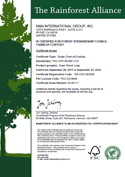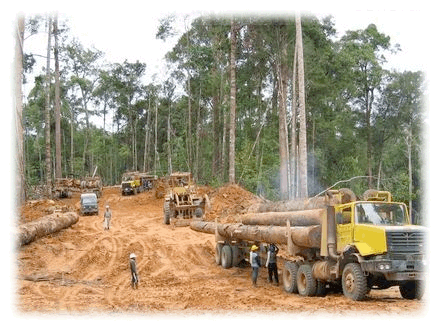What is FSC Certification?
Forest certification is a market-based means of promoting forest conservation. Certification of a forest attests to its owner's environmentally sound, socially beneficial, and economically viable management practices. The term "certified forest products" refers to those products originating in a forest that have been determined to be well-managed by an independent, third-party certification organization using international principles and criteria.
| The chain-of-custody and product labeling components of a credible certification program are designed to support the tracking of the wood fiber from the forest floor to the point of sale, providing the end customer with a trustworthy audit trail that ensures the wood they are purchasing originated in a certified well-managed forest. |  Click to Enlarge |
As the market for environmentally responsible products evolves, certification will serve as a market-based mechanism to reward superior forest management.
Who Oversees Forest Certification?
Several organizations have developed certification programs. The program developed by the Forest Stewardship Council (FSC), an international non-profit organization, has the broadest worldwide support and is the only system that has earned the endorsement of major environmental organizations, including World Wildlife Fund, Natural Resources Defense Council, The Wilderness Society, and Rainforest Alliance.
At the core of FSC's certification system are ten Principles and fifty-six Criteria for Forest Stewardship, addressing such topics as environmental impact, plantation management, management planning, and indigenous peoples' rights.
|
 |
Regional standards based on these principles and criteria are developed by FSC-designated bodies representing economic, environmental, and social interests. FSC reviews and approves the regional standards to ensure conformity with its Principles and Criteria. On-the-ground certification audits are carried out by FSC-accredited certification organizations.
What Takes Place During an FSC Certification?
Obtaining certification is a voluntary process. At the request of a forest landowner or forest manager, a multi-disciplinary team of experts conducts an audit of the woodlands and the forest management practices employed therein. The audit reviews ecological, economic, and social aspects of the operation in light of the FSC-approved standards. Each certification audit is site-specific. Practices such as modest clearcutting and use of herbicides may be allowed if justified by site conditions and the management plan
Upon passing the audit, the landowner is issued a certificate attesting to the "well-managed" status of the forestland and can use an FSC "certified" ecolabel to identify products coming from the well-managed forest. Certified operations must be re-audited every five years to maintain certification, and spot inspections are permitted. |
 |
| What is Chain-of-Custody Certification? | |
The FSC ecolabel can only be used on products that can be documented as having originated in a certified well-managed forest. "Chain-of-custody" certification provides the paper trail to verify the certified origin of the wood. Secondary manufacturers who process and add value to the wood coming from a certified forest may submit to a voluntary certification audit of their product tracking and record-keeping. Chain-of-custody certification requires that certified material be physically segregated from uncertified material. Upon completion of the chain-of-custody audit, the secondary manufacturers are certified to affix the FSC ecolabel to the certified product. In order for a wood product to carry the FSC ecolabel to the end customer, every value-added manufacturer involved with the wood components of the end product must be chain-of-custody certified. Please ask for FSC® certified products. |
|

